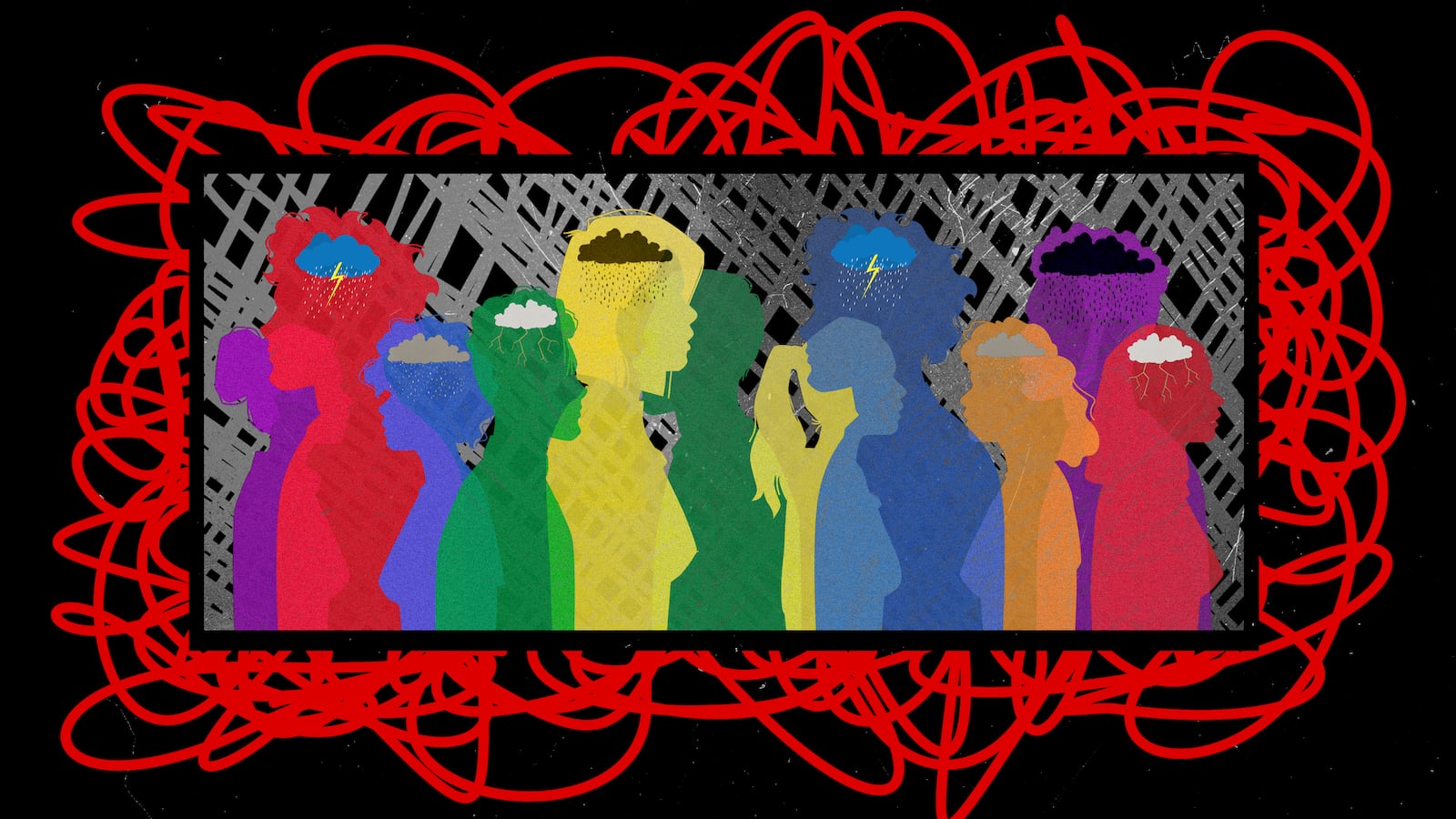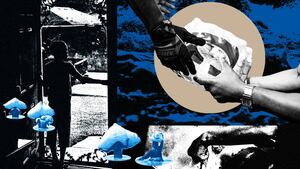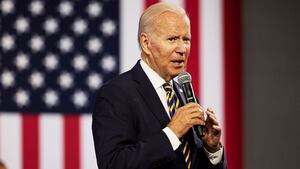The nation’s kids were already struggling before the COVID-19 pandemic.
There were school shootings in 46 out of the 52 weeks of 2019. According to the America’s State of Mind Report, the number of kids between the ages of 13-19 taking antidepressants between 2015-2019 rose a staggering 38 percent. And with millions of children consigned to remote learning during the pandemic—unable to see their friends, or have graduations, proms, or extracurricular activities for almost two years—these numbers have skyrocketed, as have attempted suicides among this same age group.

A student holds a sign during a rally outside Boston City Hall demanding schools to reopen and prioritizing high-needs students for in-person learning in 2020.
Jessica Rinaldi/The Boston Globe via GettyU.S. Surgeon General Vivek H. Murthy was even compelled to issue an advisory on the “youth mental health crisis.”
What does this crisis look like? A 50 percent increase in suicide attempt of teenage girls since 2019. And if we take these same concerns and apply them to LGBTQ youth‚ whose statistics in the areas of self-harm were already well outside the mainstream—it looks like one in five transgender or non-binary students attempted suicide in the past year, and 45 percent of LGBTQ kids seriously considered taking their own lives.
Hopes that things would just “go back to normal” for kids once schools were fully reopened have proven to be too optimistic. Children were (and continue to be) uniquely impacted by the ongoing series of crises that this country is facing.
Think about it.
While in the midst of significant periods of emotional, physical, and social development—the nation’s kids have had to reckon with the loss of over a million people to COVID, unrelenting school shootings, the catastrophic effects of climate change, and economic instability—with millions of parents and caregivers losing their livelihoods. While we as adults struggle with issues like ambient stress, languishing, and our own increased use of medications to support our mental health—we’re not also going through puberty, and unlike the nation’s youth, our brains are fully formed and matured.
And our nation’s kids are not immune from the U.S.’ hostile and unstable political climate.
Try to imagine what it must look like to a young student that the President of the United States tried to stage a coup, and that tens of millions of Americans support it! Or how they’d feel about Republicans like Florida Gov. Ron DeSantis believing that learning the candid history of America’s racist roots will incur white guilt. Imagine being a young queer kid attending school where your teacher isn’t required to show you dignity or respect by using your preferred pronouns or allowing you use of the bathroom or locker room that is in accordance with your gender identity. How should LGBTQ youth feel about Texas Gov. Greg Abbott instituting a law that has the parents of transgender youth investigated and possbibly jailed for providing life affirming medical care for their kids?
In Kansas, a judge ruled that a teacher has the authority to “out” a transgender child to their parents. And what happens when a child is outed to non-affirming parents or caregivers? The Trevor Project’s 2021 National Survey on LGBTQ Youth Mental Health reported that 28 percent of LGBTQ youth have experienced homelessness or home instability at some point in their lives—with those numbers jumping an additional 10 percent when looking at non-binary and transgender kids, specifically.
The effects of anti-LGBTQ discrimination, compounded with the myriad crises that the youth of America face are beyond alarming. In the early aughts, when headlines revealed a rash of LGBTQ suicides, we told these same kids that “it gets better.” Queer adults took to a video campaign to remind them that while things may seem dark now, their future is indeed bright. Many of us, however, are now feeling like frauds as we watch anti-LGBTQ legislation take hold across the nation.
But there’s still a reason for hope.
The bigots of the radical right might assume that queer kids will just retreat back into the closet—but they are sorely underestimating this generation.
At the beginning of this year, hundreds of Floridian students staged a walkout protesting Gov. Ron DeSantis’ “Don’t Say Gay Bill.” In Alabama, young trans kids linked arms with their parents and doctors to fight valiantly against anti-trans legislation that would put their lives and futures at risk. After the Parkland shooting in 2018, we saw young people—openly queer and straight—catapult to the front of the gun reform movement that helped to give voice and space to those most affected by school shootings: the kids.
Anti-LGBTQ conservatives believe they can shame these young people into submission, but they are ignorant to what their hate mongering is actually doing; which is creating the next generation of activists, who are utilizing various social platforms to connect to one another and the world at large. No longer isolated by the confines of their small-minded communities—they are finding outlets and virtual spaces that are reminding them not only of their power to organize, but their ability to activate their peers.

Laws in Texas have made it more difficult for transgender youth, like Sunny Bryant, to receive gender-affirming care.
Francois Picard/AFP via GettyProgress has and continues to be made, and we need to do a better job in showcasing this—to all of our kids, but especially LGBTQ kids. A cacophony of bad news shouldn’t rob them of the greater context, which is that acceptance and inclusion of LGBTQ people in America has never been greater.
Take a look at the Biden administration’s over 200 LGBTQ appointees.
Transportation Secretary Pete Buttigieg was not only the first openly gay person to make a competitive run for the presidency (he even won the Iowa caucuses!), but he’s also the first gay cabinet secretary to be confirmed by the U.S. Senate. Karine Jean Pierre is the first Black lesbian to hold the position as White House press secretary. Dr. Rachel Levine is the assistant secretary for health and the first openly transgender person to be confirmed by the Senate.
When we turn our attention from government to Hollywood, we have seen extraordinary gains in LGBTQ representation. Actress Angelica Ross was just recently named the first out Black transgender woman to be play Roxy Hart in the musical Chicago on Broadway. And many corporations, colleges, and other private entities have evolved their policies to be more inclusive, and to protect the rights of LGBTQ people.
It’s possible that as progress continues to be made, as we take two steps forward, the forces of intolerance will force us to take the occasional step backward. But while it takes time, we need to continuously remind marginalized young people that their youth will go by fast, and that things do, in fact, better.
“Children are the seed for peace or violence in the future, depending on how they are cared for and stimulated. Thus, their family and community environment must be sown to grow a fairer and more fraternal world, a world to serve life and hope,” Zilda Arns, the Brazilian activist and pediatrician said in 2006.
These are, indeed, rough times for this country—particularly for vulnerable young people. But though there are many issues and areas at which we’d love to just throw up our hands—the truth is we can’t give up, because our children are watching.
We won’t know the true impact of these developmental obstacles on our children for quite some time, but what we know is that they need our attention, our empathy, and our diligence now. And more than anything, they need to believe in hope.
As the late activist and pioneering gay politician Harvey Milk said, “without hope the us’s give up. I know you cannot live on hope alone, but without it, life is not worth living.
And you, and you, and you have got to give them hope.”









